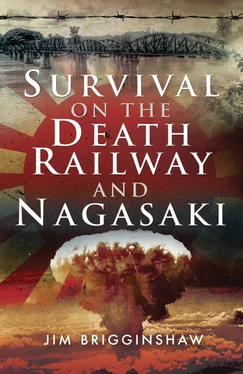Ashino turned out to be that rare creature, a Japanese the men liked. Towards the end of October 1942, he heard them talking about the Melbourne Cup.
‘Plenty cups in Tavoy. I give them, you drink.’
‘The Melbourne Cup is a horse race’, he was told.
‘You want horse race, we have Melbourne Cup here in Tavoy.’
When it was pointed out to him that a Melbourne Cup needed horses, he said, ‘Big men horses, small men ride on backs. Melbourne Cup will be important day in Tavoy, rest day for everyone.’
The promise of a rest day did it. Horses and jockeys were nominated and Ashino put up the trophies, a cup for the winning ‘horse’ and a whip for its rider.
An officer told him they couldn’t have the Melbourne Cup without the governor-general.
Ashino was puzzled. ‘What is governor-general?’
‘He’s the Queen’s representative in Australia. Wouldn’t be the Melbourne Cup without him.’
‘Then one man will be governor-general’, Ashino said.
‘What about his carriage?’
‘Governor-general has carriage?’
When told that he did, Ashino said he’d get him a Burmese yak cart.
‘And what about the Melbourne Cup ball?’
Ashino grinned. ‘You joking to me. You don’t need ball for horse race. Ball for football.’
The Australians explained that a Melbourne Cup ball was about music and dancing.
‘Ah so, music’, Ashino said. ‘I get Burmese orchestra.’
‘And girls?’
Ashino shook his head. ‘No girls. Your men the girls.’
And so it was decided. By the time the second Tuesday in November arrived, a straight strip of the compound had been cleared for the racetrack. Seating appeared from nowhere, and even grandstands sprang up.
Australian officers were appointed as clerk of the course, starter, stewards and track detectives. Before starting time, the track detectives arrested Sergeant Ashino and charged him with carrying weapons on the course and harbouring undesirables, to wit Australian prisoners of war. Sergeant Ashino’s sword belt and pistol were taken from him. Everybody held their breath. Taking weapons from a Japanese meant death, but Ashino played along. He submitted to being marched to a stewards’ inquiry and made to stand to attention between two escorts. The maximum sentence, a fine of one hundred Burmese cigars, was imposed.
Ashino paid up. He handed over a full carton of the best Burmese cheroots, which were passed on to those who were too sick to attend the race meeting.
Near starting time, Governor-General Sol Heffernan emerged from a hut. He wore bits and pieces of the uniforms of many nations. On the breast of his worn-out tunic were homemade medals, and his cap bore the insignia of the Imperial Nipponese Navy. He was barefooted, but so were many of the others. Cheers greeted the vice-regal carriage as it lumbered up the dusty straight, hauled by a yak. Sol waved his hand regally to acknowledge the welcome.
The bookie’s ring had been busy, although no clear favourite had been installed because of doubts as to whether any of the starters had the strength to finish a hundred-yard race. The best price on offer was two-to-one, payable in cigarettes.
When the race started, skinny riders urged their equally skinny mounts onwards. Falls were plentiful. Two starters managed to get to the post, but payouts on winning bets were delayed when the protest signal went up. The second-placed rider had protested against the winner, claiming that the weights weren’t right. The stewards dismissed the protest as frivolous because none of the bag-of-bones jockeys would have moved the needle on the scales much anyway, that’s if anyone had actually had some scales.
Sergeant Ashino presented the trophies and announced that refreshments would be provided in the guards’ mess hall. There, each prisoner was given a cup of tea and a couple of rice cakes. It was a banquet, paid for by Ashino out of his own pocket. He also bought and gave the men a large wooden chest of tea. They couldn’t believe it. They hadn’t had tea since their capture in Singapore.
The Melbourne Cup ball that night in the concrete school building had the music and dancing that Sergeant Ashino had promised. The Burmese orchestra was more than a trifle off-key, but nobody noticed. The dancing ‘girls’, bearded and dressed in everything from grass skirts to canvas lap-laps, didn’t lack partners on the dance floor until they asked the Japanese guards for a dance. The guards left in a hurry.
The best looker among the girls, none of whom would have troubled a Miss Australia contest, was Lieutenant Teddy Wheeler from Brisbane. Wheeler had a deceptive baby face that belied his rugged fighting ability. His men would have followed him to hell and back.
When Melbourne Cup day 1942 was over in Tavoy, the prisoners were quiet on their sleeping platforms that night. They felt more homesick than ever.
Not long afterwards, the Japanese army command ordered all prisoners to be moved from Tavoy to a new area. The men questioned Sergeant Ashino as to where they were going, but he had no idea. He did, however, suggest to his superiors that the men be left where they were. They liked him and he liked them, he told the Japanese brass.
In return, he received a belting for questioning an order.
After the prisoners left Tavoy, they never saw Ashino again. He was the one Japanese who had shown them compassion.
They didn’t know it at the time, but ahead of them lay two and half years of hell.
CHAPTER FIVE
NIPPON’S RULES
THE TAVOY PRISONERS were crammed into open army trucks, thirty men to a truck, with no protection from the scorching sun. It was a horror journey over rugged country. The crossing of the deep canyons was by crude bridges whose flimsy decking had two narrow wheel tracks. If a truck strayed from the tracks it would tumble into the depths.
This had ‘Schoey’ Schofield petrified because he had a morbid fear of heights. When they were crossing the bridges with a dizzying drop on either side, he’d sit with his army hat over his eyes. Only when someone told him they were safely across would he take the hat away.
On one bridge, they were only part-way across when Jimmy Harris, sitting opposite. said, ‘Hats off, we’re over.’
Schoey took the hat away. On either side of him was empty space. Terrified, he fell to the floor of the truck.
‘You bastard, Harris’, he moaned while Jimmy sat grinning. ‘I’m not getting up until we get to where we’re going.’
He was still lying on the floor when the truck rumbled to a stop and the men were ordered to get out. There were no more bridges. From there on, they’d been blown up by retreating British troops. The trucks could go no further. The prisoners had to walk.
Schoey was grateful for this, but before long he was wishing he was back in the truck. Loaded with cooking gear-the prisoners had few other possessions-they stumbled over rough roads, then along a railway line running up the west coast of Burma to Moulmein. The sharp metal on the line sliced into the feet of the prisoners, most of whom were barefooted.
Soon everyone was hobbling, but the Japanese marched them day and night, allowing only an occasional rest. Over three days and nights, they covered a hundred miles. When they reached their destination, Thambuzyat, many of them were more dead than alive.
Thambuzyat was the main workshop for the building of the Burma–Siam railway from the Burma end. It was a huge camp of about fifty bamboo and attap (palm thatch) huts.
When they arrived, the exhausted prisoners weren’t allowed to rest. Work parties were ordered out to gather wood for the cooking fires, but not before the three thousand prisoners were paraded for an address by the officer in charge of the camp, Lieutenant Colonel Nagatomo.
Читать дальше












